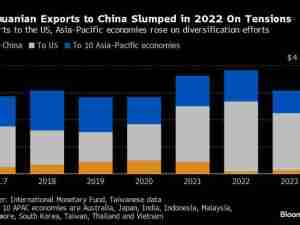China’s steel exports posted the strongest month since 2016, weeks after US Treasury Secretary Janet Yellen used the industry as an example to warn on Chinese overcapacity in emerging industries.
Overseas shipments reached 9.9 million tons in March, about 25% higher than a year earlier and capping a very strong quarter, according to government data. China’s prolonged property crisis has pummeled demand for steel at home, spurring traders to sell in more lucrative markets.
The strength of China’s steel exports carries significance well beyond the industry itself. Yellen last month cited what she called a record of “substantial overinvestment and excess capacity” in steel as she cautioned on China’s early grip on solar to electric vehicles and batteries.
“Fundamentally, it’s about weak steel demand in China,” said Tomas Gutierrez, an analyst at Kallanish Commodities. “Chinese material is becoming quite competitive again with prices falling again domestically, and I think exports will be quite strong this year.”
China’s demand for steel dropped by more than 3% last year, according to the World Steel Association. Rising exports have therefore helped mills to keep churning out material, in turn bolstering demand for iron ore from major miners like Rio Tinto Plc. and BHP Group Ltd. The nation made about 1 billion tons of steel last year.
Further Afield
Prices for Chinese steel have plunged this year, with benchmark hot-rolled coil fell close to $500 a ton at the end of March, the lowest since 2020. Analysts from Citigroup Inc. said their base case was still for a moderation of net exports this year.
A flood of Chinese steel in 2015 and 2016 triggered trade complaints and protectionist measures worldwide. Volumes have moderated since then, partly due to the closure of many old Chinese plants and because of growing trade barriers. But China has also been a stronger market President Xi Jinping’s push to wean the economy off real estate.
Chinese steel had been reaching more distant destinations during the recent months, according to Citi. Supplies to India more than doubled in the first two months of this year, while exports to Brazil rose 87%. But nearby East Asian nations — led by Vietnam and South Korea — remain by far the biggest buyers.
©2024 Bloomberg L.P.




